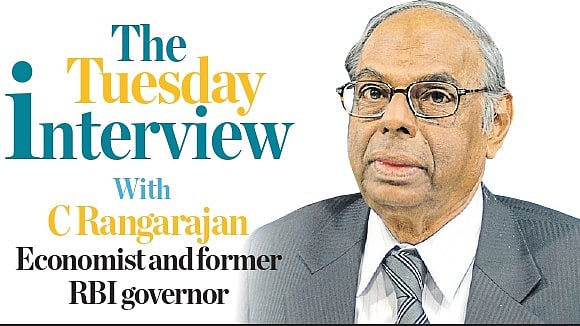
Credit: DH Illustration
Several East Asian countries such as Japan and South Korea made rapid progress in the post-World War period by adopting an export-led growth strategy. As India aspires to become a developed nation by 2047, can their strategy be replicated? Eminent economist and former Governor of Reserve Bank of India C Rangarajan says for India this old strategy won’t work as the world trade environment has changed. In an interview with DH’s Gyanendra Keshri, Rangarajan also delved on the need for continuity of reforms to achieve the Narendra Modi government’s Viksit Bharat@2047 vision. Excerpts:
How do you see the feasibility of India achieving the status of ‘developed nation’ by 2047?
International financial organisations and multilateral institutions currently classify countries with per capita income of over $14,000 as developed countries. In 2047, this level may be higher. India’s per capita income now is around $2,400. This shows the distance that we must travel. Based on some assumptions about future exchange rate of rupee and domestic inflation, we need to have an average annual real growth rate of 6-7 per cent to achieve this level of per capita income.
What is the pace of growth required for India to become a developed country?
One simple arithmetic is that on the assumption of an ICOR (incremental capital output ratio) of 5, which is what we have seen in recent years, a 7 per cent rate of growth will require a real gross fixed capital formation (GFCF) rate of 35 per cent of GDP. We are close to 35 per cent as of now.
The recent increase in real GFCF rate has been largely due to increase in public capital expenditure, especially that of the Union government.
This growth in government capex cannot be sustained because this has been accompanied by a high fiscal deficit of the Centre which was in the range of 6.7 per cent, 6.4 per cent, and 5.6 per cent in the three post-Covid-19 years. What is required is a pickup in private investment by 1 to 2 percentage points of GDP.
To achieve this, we need to create an appropriate environment for
private investment — both corporate and non-corporate — to increase.
This depends upon a stable financial and fiscal system. The importance of price stability in this context cannot
be ignored.
What should be the roadmap to achieve this target?
Post-World War II, many of the East Asian countries adopted an export-led growth strategy and made rapid progress. Subsequently, China adopted a similar policy. China’s share in world exports was 0.6 per cent in 1970. By 2022, it went up to 11.9 per cent. In contrast, although India’s share in world exports was also 0.6 per cent in 1970, it could increase only to 2.5 per cent by 2022.
However, the world trade environment has changed. The voices of protagonists of free trade are getting weaker. Some countries have turned distinctly protectionist. For a variety of reasons, growth will slow down in developed countries. For India, this old strategy is not open. This does not mean that we should not focus on exports. That would be a wrong approach. Exports are a test of efficiency. We have shown our excellence in export of services. We need to prove it in terms of merchandise also. We cannot ignore external demand as one of the drivers of growth.
Broadly speaking, the strategy may be multi-dimensional: we need to emphasize exports, services, manufacturing, agriculture etc. It would be useful to identify our ‘sunrise’ industries. For example, the food processing industry may be given a high priority as it is labour-intensive, it helps agriculture, and has export demand. The Russia-Ukraine war threw up an important issue. Because of the supply disruptions caused by the war, many countries started thinking about being self-sufficient with respect to ‘critical imports’.
In this context, India also thought about manufacturing semiconductor chips, even though the idea was not new. In all cases of ‘import substitution’ we should not forget about cost. What is needed is efficient import substitution. Atmanirbharta should not degenerate into inefficient ‘import substitution’.
Given India’s political system where we have elections every five years is it feasible for a government to prepare a roadmap for 25 years? What should be the approach?
Let us look back at history. In 1991, reforms were initiated. Since then, there have been many governments belonging to different parties. But reforms have continued. There may have been some shift in emphasis. But broadly the spirit of liberalisation has continued. The same may happen in the next two decades as well. What is needed is a consensus in approach not in details.